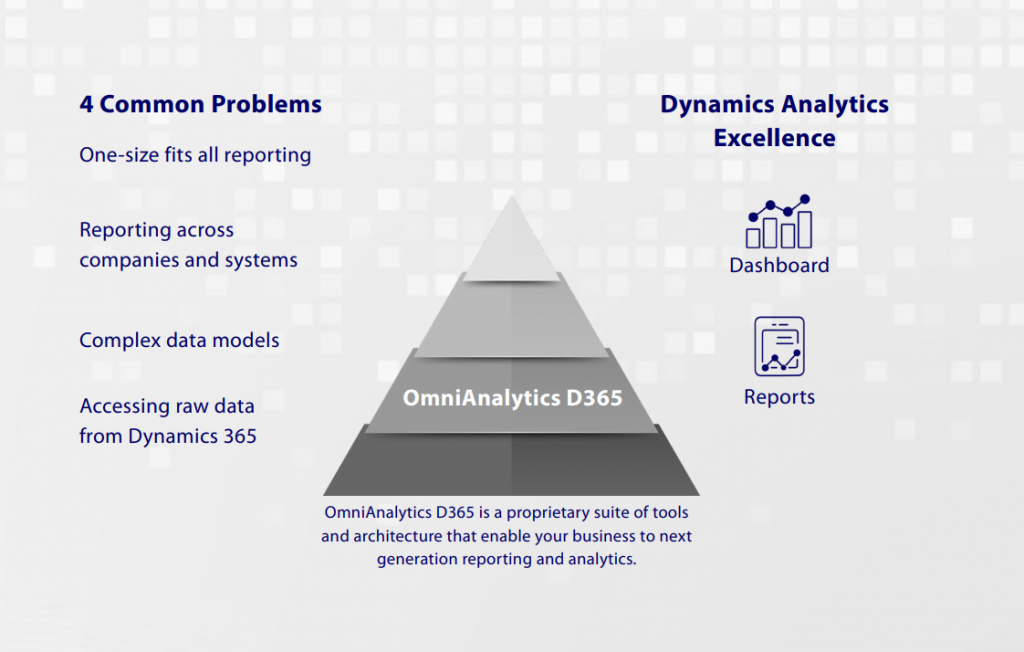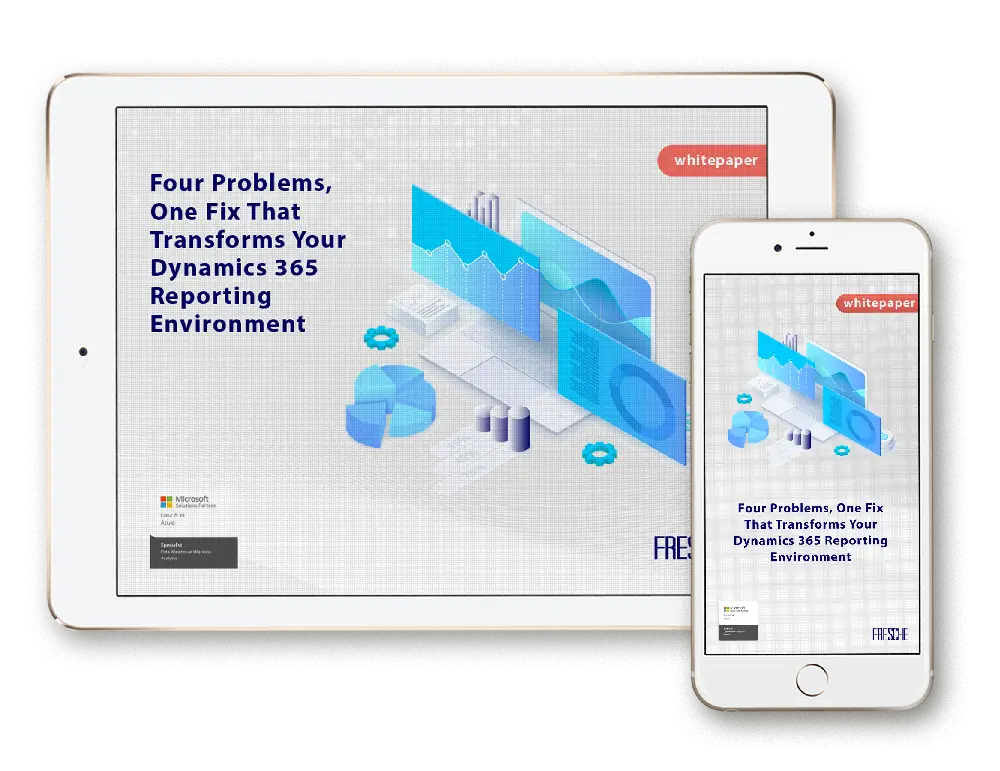
If you’re running Microsoft Dynamics 365 ERP and struggling with reporting limitations, you’re not alone.
After working with dozens of Dynamics installations over the past 15 years, we’ve discovered a troubling pattern: most organizations are leaving tremendous value on the table when it comes to their data and analytics capabilities.
Every major ERP solution on the market struggles with reporting, whether it’s SAP, Oracle, or NetSuite. Dynamics 365 ERP is no different. While D365 is undeniably powerful, its out-of-the-box reporting capabilities often fall short of what modern businesses need to stay competitive.
The result? Organizations get trapped in a costly cycle of expensive customizations, limited reporting capabilities, and missed opportunities for data-driven decision making.
But it doesn’t have to be this way.
What if you could achieve what we call “Dynamics Analytics Excellence” in weeks rather than months — without breaking your budget or compromising your system’s integrity?
The Vision: Dynamics 365 ERP Analytics Excellence
Picture this: Your Dynamics reporting environment delivers exactly what your business needs. Complex analytics across multiple business entities are generated in minutes, not weeks. Adding new data sources requires days, not months of development work. Your team analyzes insights instead of wrestling with data extraction and manipulation.
This isn’t just wishful thinking. It’s what we call Dynamics Analytics Excellence, and it’s absolutely achievable with the right approach.
Dynamics Analytics Excellence means having:
- Immediate Access to all your critical business data in formats that actually make sense for decision-making
- Unified Reporting that seamlessly combines Dynamics 365 ERP data with information from other systems
- Scalable Architecture that grows with your business without requiring constant expensive customizations
- Self-Service Capabilities that empower your team to generate the reports they need without IT bottlenecks
- Future-Proof Foundation built on modern, supportable technologies that won’t become obsolete
The Hidden Cost of Inadequate D365 ERP Reporting
Every day, business leaders across industries are making critical decisions with incomplete information. They’re operating with fragmented data views, struggling to consolidate reporting across multiple business entities, and relying on manual processes that eat up valuable time and resources.
The impact goes beyond just inconvenience. When your reporting infrastructure can’t keep pace with business needs, you’re essentially flying blind in a competitive marketplace where data-driven insights can make or break your success.
How many times have you needed a quick answer about performance across different business units, only to discover that generating that report would take days or weeks of IT resources? How often have you wished you could easily combine Dynamics data with information from other critical applications to get a complete picture of your business performance?
These aren’t just operational inefficiencies; they’re strategic disadvantages that compound over time.
4 Critical Problems Plaguing D365 ERP Reporting
Through extensive experience working with Dynamics environments, we’ve identified four fundamental problems that consistently emerge across organizations of all sizes and industries. These issues aren’t random, they’re systematic challenges built into the very nature of how most organizations approach Dynamics ERP reporting.

Problem #1: The One-Size-Fits-All Trap
Here’s the truth that most consultants won’t tell you: all businesses are fundamentally different, yet most D365 reporting solutions treat them as if they’re identical. While every business shares basic financial reporting requirements like balance sheets and income statements according to GAAP, that’s where the similarities end.
Your organization has unique processes, specific metrics that matter to your industry, and custom workflows that drive your competitive advantage. Yet standard Dynamics reporting treats your business like every other business, forcing you into rigid templates that don’t reflect your operational reality.
The result? You end up with reports that technically contain data but don’t actually answer the questions that matter most to your business success.
Problem #2: Data Model Complexity That Multiplies
The second major challenge is more technical but equally devastating in its impact. D365 data models can become incredibly complex, especially when customizations are involved. What starts as a simple reporting need can quickly spiral into a web of dependencies and complications.
Organizations often find themselves at the mercy of high-priced data specialists who become bottlenecks for every reporting request. Simple changes require extensive development work, and critical reporting needs get delayed for weeks or months.
Even worse, these customizations often create new problems down the line, making future upgrades more difficult and expensive.
Problem #3: The Consolidation Nightmare
Most organizations don’t operate in a single-system vacuum. You likely have multiple business entities, various data sets from critical applications outside of Dynamics, and information scattered across different platforms.
The challenge of consolidating this information into coherent, actionable reports is where many organizations hit a wall. The technical complexity of bringing together data from multiple sources, ensuring accuracy and consistency, and maintaining real-time or near-real-time updates can seem insurmountable.
Basic financial reporting across multiple business entities becomes a manual, error-prone process that consumes enormous amounts of time and resources.
Problem #4: The Dynamics 365 ERP Data Extraction Challenge
For organizations that have migrated to Dynamics 365, there’s an additional layer of complexity that many don’t anticipate. Raw data extraction from Dynamics 365 presents unique challenges compared to older Dynamics installations. While Dynamics 365 offers a next generation platform that enhances the product line, direct database access is no longer possible in the Software as a Service (SaaS) environment.
This limitation, combined with the standardization issues and data model complexity mentioned earlier, creates even greater reporting challenges for online customers.
If you need to access data in your Dynamics 365 ERP environment, you are limited to two mechanisms:
- Synapse Link
- Fabric Link
We often recommend the Synapse Link approach as it eliminates the high cost of Dataverse storage, using Azure Storage instead. However, you will incur compute costs to transform the data for downstream use. Fortunately, all the problems described above can be bridged and the process is simple, if you have the right tools and skills to make it happen. It can be done in weeks instead of months, giving your company an opportunity to leapfrog your competition and creating value from your raw data assets. This is covered in more detail in the full whitepaper version.
Why Traditional D365 ERP Analytics Solutions Fall Short
Most organizations attempt to solve these problems in a piecemeal fashion. They might invest in custom report development to address the standardization trap (Problem #1), hire expensive consultants to manage data model complexity (Problem #2), implement manual data consolidation processes for multi-entry reporting (Problem #3), and struggle with various extraction tools to handle SaaS limitations (Problem #4).
This fragmented approach created more problems than it solves. Not only is it expensive and time-consuming, but each point solution adds another layer of complexity to your technology stack. You end up with multiple vendors, disparate systems that don’t communicate well, and a web of dependencies that becomes increasingly difficult to maintain and scale.
Even worse, these isolated fixes often conflict with each other. A custom report that works perfectly today might break when you upgrade your extraction tool. A consolidation process that handles current business entities might fail when you acquire a new company or expand into new markets.
The results? Organizations find themselves trapped in an endless cycle of patches and workarounds, spending more time managing their analytics infrastructure than actually using it to drive business value.
What’s needed is a unified approach that addresses all four problems simultaneously while creating a scalable foundation for future growth and success.
A Modern Approach to an Age-Old Problem
The solution isn’t to abandon Dynamics 365 ERP or patch over its reporting limitations with expensive custom development. Instead, the answer lies in creating a modern analytics environment that sits alongside your Microsoft Dynamics investment, enhancing its value while solving the fundamental reporting challenges.
This approach leverages cutting-edge cloud technologies to create a centralized data repository that can handle the complexity of your D365 ERP data model while remaining simple and intuitive for end users. It provides the flexibility to add any customizations without impacting your core Dynamics environment, and it scales seamlessly as your business grows.
Most importantly, this solution can be implemented in weeks rather than months, providing immediate value while setting the foundation for long-term analytics success.
Organizations that achieve this level of Dynamics 365 Analytics Excellence don’t just solve their immediate reporting problems — they gain a sustainable competitive advantage. They can respond faster to market changes, identify opportunities earlier, and make decisions based on complete, accurate information rather than fragmented data views.
Every week that passes with these four problems unsolved means more missed opportunities and slower decision-making compared to your competition. The good news is that there’s a proven solution that addresses all four challenges simultaneously—and it can be implemented much faster than traditional approaches.
Your Next Step Toward D365 Analytics Excellence
The four problems we’ve outlined are costing your organization time, money, and competitive advantage every day they remain unsolved. But you don’t have to accept these limitations as permanent features of your Dynamics environment.
There is a proven path forward that’s been successfully implemented across dozens of organizations and refined based on real-world experience and results.
If you’re ready to discover how your organization can achieve Dynamics Analytics Excellence, we’ve created a comprehensive whitepaper that details:
- The complete breakdown of all four common Dynamics reporting problems
- A detailed technical overview of the OmniAnalytics D365™ solution
- Future-proofing strategies for your analytics investment
Don’t let another quarter pass while your competitors gain analytical advantages. The time to transform your Dynamics reporting environment is now.



